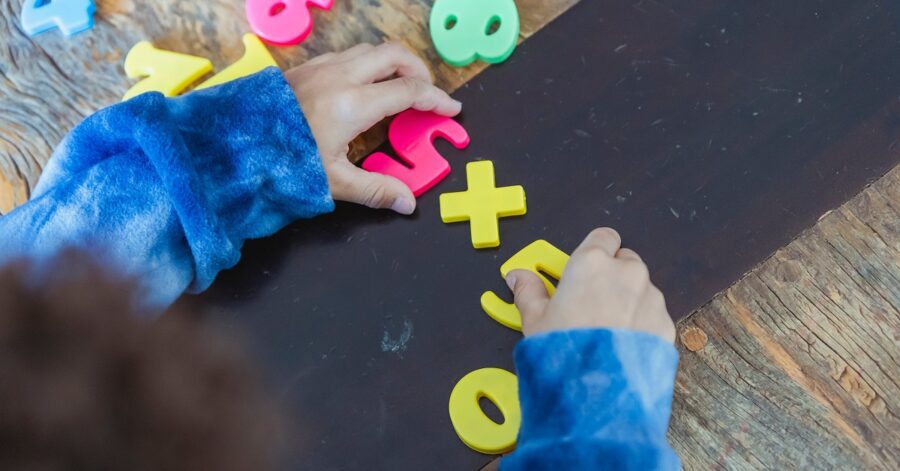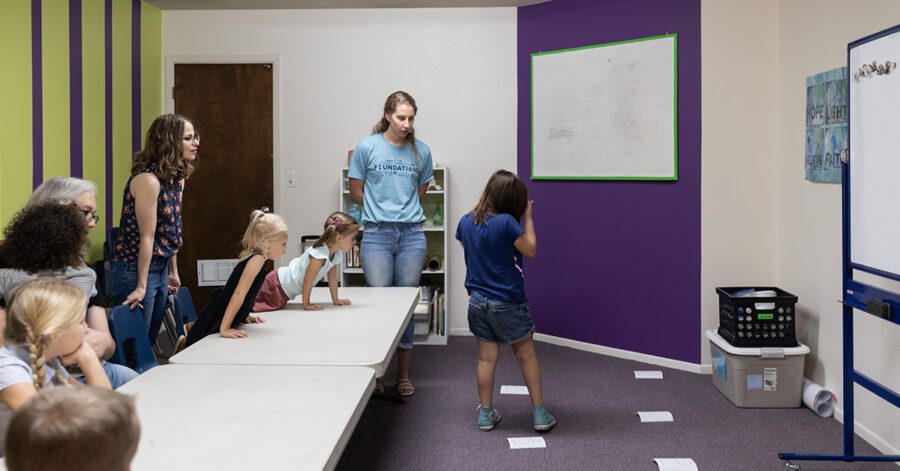According to one study by the Organization for Economic Cooperation and Development (OECD), approximately 33% of 15-year-olds living in developing nations experience significant levels of math anxiety.1OECD (2015), “Does Math Make You Anxious?”, PISA in Focus, No. 48, OECD Publishing, Paris, https://doi.org/10.1787/5js6b2579tnx-en. Other studies have indicated that up to 93% of American adults share at least some degree of math anxiety.2Luttenberger, Silke, et al. “Spotlight on math anxiety.” Psychology research and behavior management vol. 11 311-322. 8 Aug. 2018, doi:10.2147/PRBM.S141421. Why do so many people fear math? And, more importantly, how can we overcome that feeling and instead inspire a lifelong love of math? And, most importantly, what would a math curriculum that teaches students not to fear but to appreciate math even look like?
In this blog post, Kirsty Gilpin, lead mathematician and curriculum developer for Classical Conversations’ upcoming homeschool math curriculum, The Math Map, examines why math is so hard for so many students and then shares the classical approach to math taken by The Math Map.
Why Is Math So Hard for So Many Students?
To understand why so many people have an uneasy relationship with mathematics, we may find it helpful to take a brief glance at the history of math education. The Math Map rejects the fallacy that some people are math people while others are not and instead invites everyone into the mathematics conversation.
The Historical Tension between Theory and Practice
Whether one looks at Western or Eastern civilizations, a historical tension between the theoretical and the practical exists within mathematics education. Great philosophers sought universal truths through numbers. Trade required people with the ability to conduct transactions. Within geometry, mathematicians were busy proving abstract relationships and concepts, while builders made use of the same relationships using concrete, often non-numerical, techniques.
Math Education in the Industrial Revolution: Practice over Theory
By the 19th century, Western and Eastern mathematics had merged, and mathematics earned a fixed place in the canon of advanced studies. Huge gains were made in theoretical mathematics through the work of giants such as Newton and Leibniz. At the same time, the Industrial Revolution radically changed the face of education, leading to the first compulsory attendance laws in many places around the world.
Within schools, the focus was on the practical and technical needs posed by factories and machinery, emphasizing memorizing facts and algorithms and with less time devoted to the deeper understanding required by a more theoretical study.
Math Education during the Space Race: Theory over Practice
In the 1960s, the US and other countries responded to the space race with a new awareness of the need for students who could both calculate and understand new concepts such as place value, set theory, and algebraic inequalities. Memorization as an educational pedagogy began to fall out of favor as the pendulum swung to prioritizing understanding.
Books to support New Math, as it was called, were plentiful, but teachers were poorly prepared. Without an underlying knowledge of facts and relationships previously acquired through memorization, students struggled to gain the understanding that was the preeminent goal. While the New Math phenomenon was short-lived, the books and their influence remained, laying the groundwork for how many of today’s homeschooling parents were taught.
The Consequences of New Math
The shift from memorizing fundamentals to understanding without knowledge led to generations of students who believed they were not math people. More recent recognition of the importance of math literacy and numerical competence has led to many attempts to improve the level of math education, especially in the West. However, in the United States, the Common Core continued the trend of seeking understanding without ensuring a firm foundation of knowledge. Algorithms designed to teach understanding simply become the new memoria while students are not well-equipped to memorize anything.
Further compounding students’ struggles to become fluent in the language of mathematics, the introduction to concepts is linked to calculation skills in most modern math curricula. Though not encouraged to memorize calculation facts, students without strong calculation skills may not be introduced to, let alone be able to master, more advanced concepts. Students who do progress become frustrated with the burden of assimilating and applying large amounts of new knowledge simultaneously.
The Failures of the Traditional Math Curriculum
The underlying tension between the theoretical and the practical leads to confusion in the classroom. Students ask for practical applications for the mathematical understanding they pursue, but much of high school mathematics is not practically applicable to the majority of students. Teachers, ill-equipped to justify the theoretical pursuit of math, leave students feeling unmotivated to pursue mathematical studies.
This is further compounded by four factors.
1. Elementary Teachers Are Also Math Hesitant
First, many elementary-level teachers, who are a student’s primary introduction to mathematics, are often math hesitant and unlikely to launch students with a passion for math.
In fact, research has shown that elementary teachers experience higher levels of math anxiety than many other professionals in other fields, and this anxiety, in turn, affects student performance.3Ramirez, G., Hooper, S. Y., Kersting, N. B., Ferguson, R., & Yeager, D. (2018). “Teacher Math Anxiety Relates to Adolescent Students’ Math Achievement.” AERA Open, 4(1). https://journals.sagepub.com/doi/10.1177/2332858418756052
2. Math Is Not Well-Integrated with Other Subjects
Second, math is traditionally taught without integration with other subjects and without context to a larger world or body of learning.
Teaching math in isolation subtly and sometimes overtly reinforces that math for the masses is only valuable if it is practical and that only smarter students should pursue math for the sake of math itself.
3. Math Concepts Are Rarely Revisited in the Educational Journey
Third, math is one of the few academic subjects with a clear (though not immutable) sequence of courses.
As policymakers push students to achieve ever more, students are frequently expected to understand concepts before they are developmentally ready, and a student’s failures may be interpreted as a lack in the student rather than a prompt to revisit the ideas later in the educational journey.
4. Math Education Overemphasizes Calculation
Finally, the emphasis on calculation as a marker of a student’s accomplishment leaves little room for students who almost get it.
Instead, minor errors can lead to wrong answers, leaving students frustrated and discouraged.
The Consequences of New Math’s Failures
Parents today bear the legacy of the New Math failures.
Rather than all students being told they were capable of memorizing facts, schools, teachers, and their parents reinforced the idea that some students are “math people” and some are not, giving students an excuse for not pursuing math understanding.
A parent’s math hesitancy may lead to a lack of confidence in directing their children’s math education, and consequently, online curricula and specialized tutoring centers take advantage of parent hesitancy and promote their products to remove the parent as the student’s primary math educator.
The Math Map: A Homeschool Math Curriculum that Inspires a Love of Math
The authors of The Math Map believe that the Biblical mandate to teach our children includes teaching them how to learn the grammar of mathematics, how to ask questions that develop an understanding of mathematics, and how to share their understanding with others through the correct use of the language of mathematics.
We further believe that the route to success in a child’s math education is by recovering the learning of the parents to equip them to teach their children. The Math Map is designed to meet the needs of homeschool parents while ensuring a high-quality math education for students.
The Math Map is a classical curriculum that begins with memorizing knowledge, provides practice to build understanding, and leads students to develop wisdom by integrating math with other strands. Students will master math facts and gain fluency in computation independently from the introduction to more advanced topics, thus inviting all students into the math conversations that span millennia.
Like all other subjects, mathematics is essential for us to know God well. The Math Map provides the directions and guidance needed to achieve that goal in your homeschool.
Further Reading
Check out the following articles to explore the importance of math and the ways in which The Math Map helps students learn the language of math and overcome math anxiety.
Trace, Draw, Copy—Becoming a Math Person the Naturals Way
Also, be sure to follow The Math Map on Facebook!





